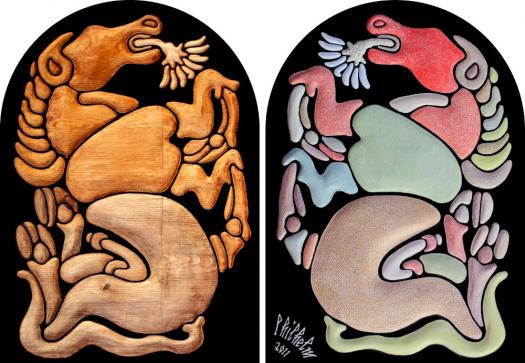Quick access :
BABYLONIAN
MINOAN
ETRUSCAN
ART GALLERY
|
 |
| P158 & P159 Cheval scythe à l’arrière-train retour | | Size (HxW) : | 54x39 cm | | Weight : | 5000 g | | Style : | Strange Art | | Technic : | Wood, painted relief | | Theme : | Animals & pets | | Category : | Sculpture | | Price : | Euros 15000 | | Year : | 2011 | | Desc. : | Scythian horse to the rear end back, carved in bas-relief wood and a single print in plaster, reversed, enhanced and colored : Each 54 x 39 cm. This magnificent animal was an ornament of a horse harness princely certainly, because recovered in a large Kurgan in the city Sagly Bajy in the region of Tuva on the border of Mongolia. (The great warrior s' was buried with his weapons and perhaps his horse, plus containers that contained food.) The original bronze is in the Hermitage Museum in St. Petersburg, it measures 4.2 x 5cm and date of IV century BC For the pleasure to discover again, here presented in my own way, carved in low relief in negative in a wooden pine assembled here fifty years, and from this mold, to draw a single plaster reinforced then raise it to give it more volume, and this, with components of polyesters, polish, and paint it with acrylics and finish with a mesh of small circles superimposed with paintings Interfering mixed with iridescent. Is it necessary to clarify that the two bas-reliefs together form a single work? Now turn to the art of the steppes or Scythian art, an art which is essentially composed of decorative items such as jewelry, decorations, weapons and equipment of the rider, the horse harness, produced by the nomadic tribes of the Pontic steppe stretching from Kazakhstan to the modern Baltic Sea. These nomads were among the oldest horse breeders in the world! Nomadic peoples have represented many scenes of hunting and fighting between animals. The theme of the Wild, a cat or a bear jumping on its prey, is very common. Everyday scenes of horse breeding and sheep are also shown. The Assyrian art has brought a taste of realism and naturalism to his tribes, who then sent throughout Eurasia, including the Germanic peoples and Asian. China has received from such an important contribution of realism of the Art of the Steppes at various Mongol invasions. Deltas of the Black Sea to the plains of Mongolia lies the vast steppes of the band. It crosses the entire Asian continent. It is the road of the nomads, not to be confused with the Silk Road, which connected with one another, further south, the towns of sedentary. The nomads have always fascinated sedentary. They borrowed their techniques, such as metallurgy, and with these loans they have developed a culture powerfully original. In return, they were irrigated, fertilized crops they grazed, or in which they competed, giving them the echoes of unknown worlds. The art of the steppes keeps its mystery. He was born anywhere. (A crib can be a vagabond?) It has the refined taste of travelers who can snap up the best in their path to transform it according to their requirements. Nothing in common with those people who set up shop, who build palaces, silos, sanctuaries where they can accumulate, spread out, getting lost in long diversions. The art of the nomads going straight to the point, it does not separate the useful from the pleasant. It does not tolerate dead weight, spartan, but impregnated gestures and daily rituals. |
| |
  |
© All of the images on this website are copyrighted original artworks by their author and are protected by international copyright law. No materials in this gallery may be reproduced, copied, downloaded, or used in any form without written permission of the contemporary artist Philhelm.
|


